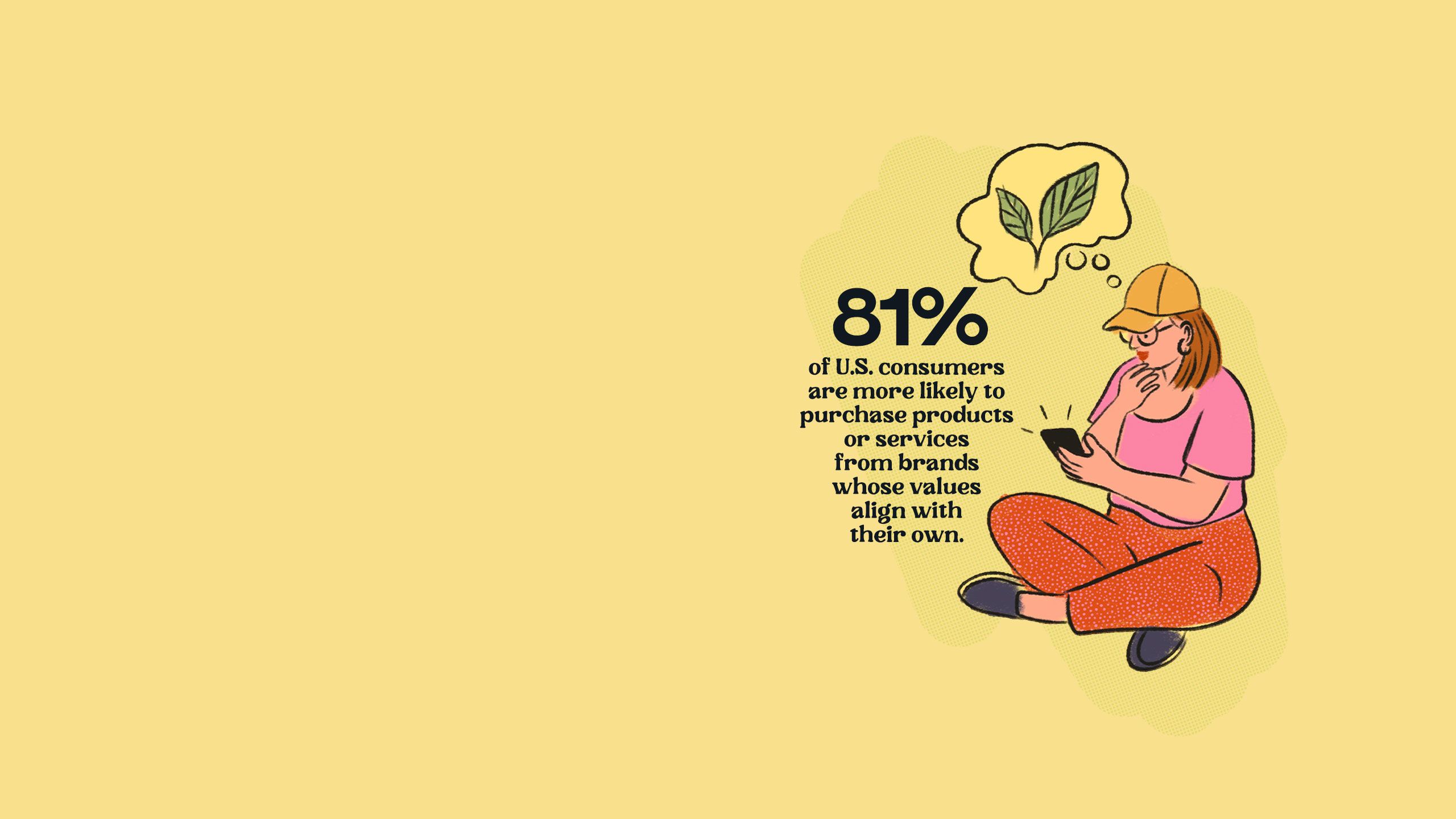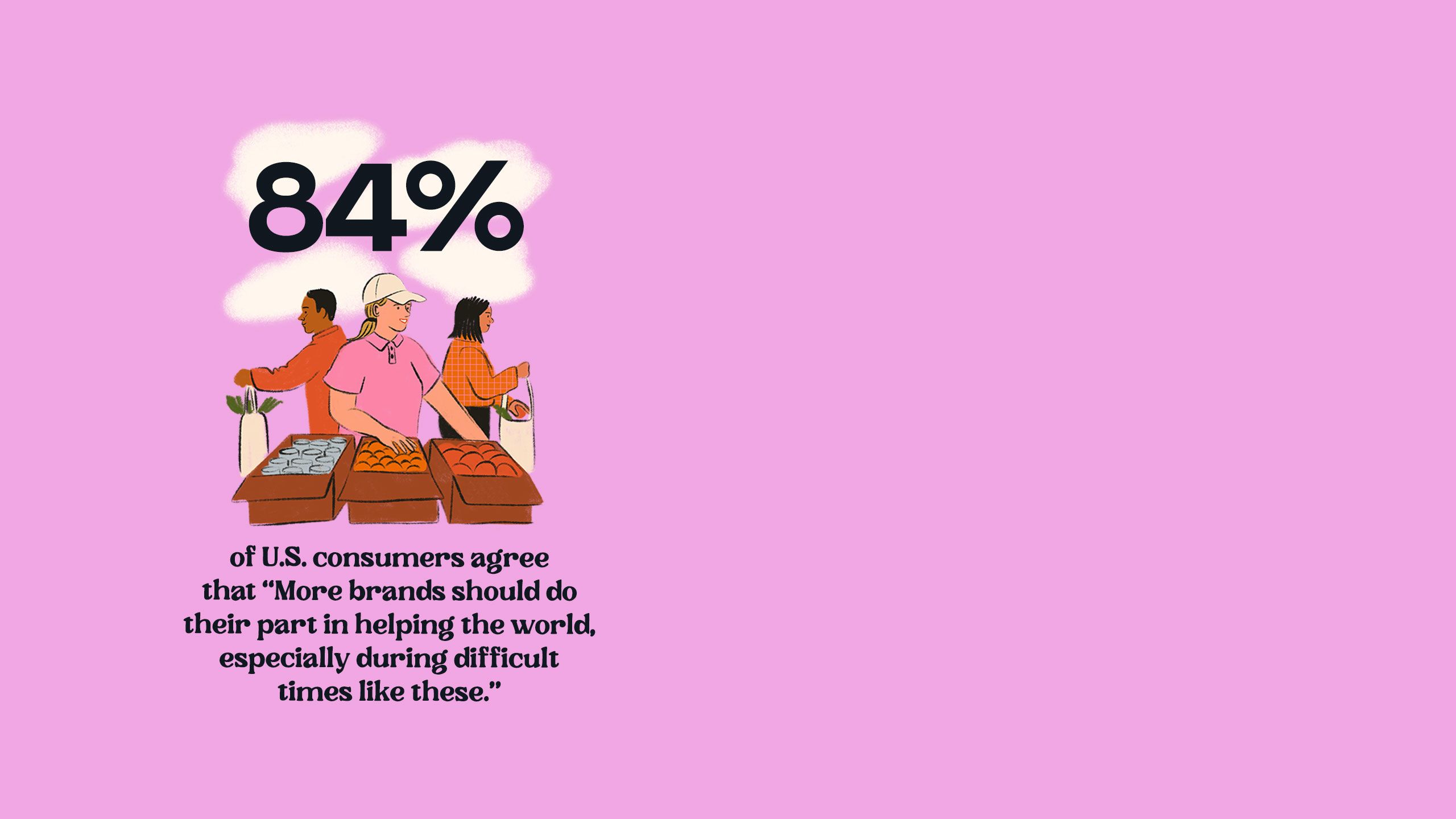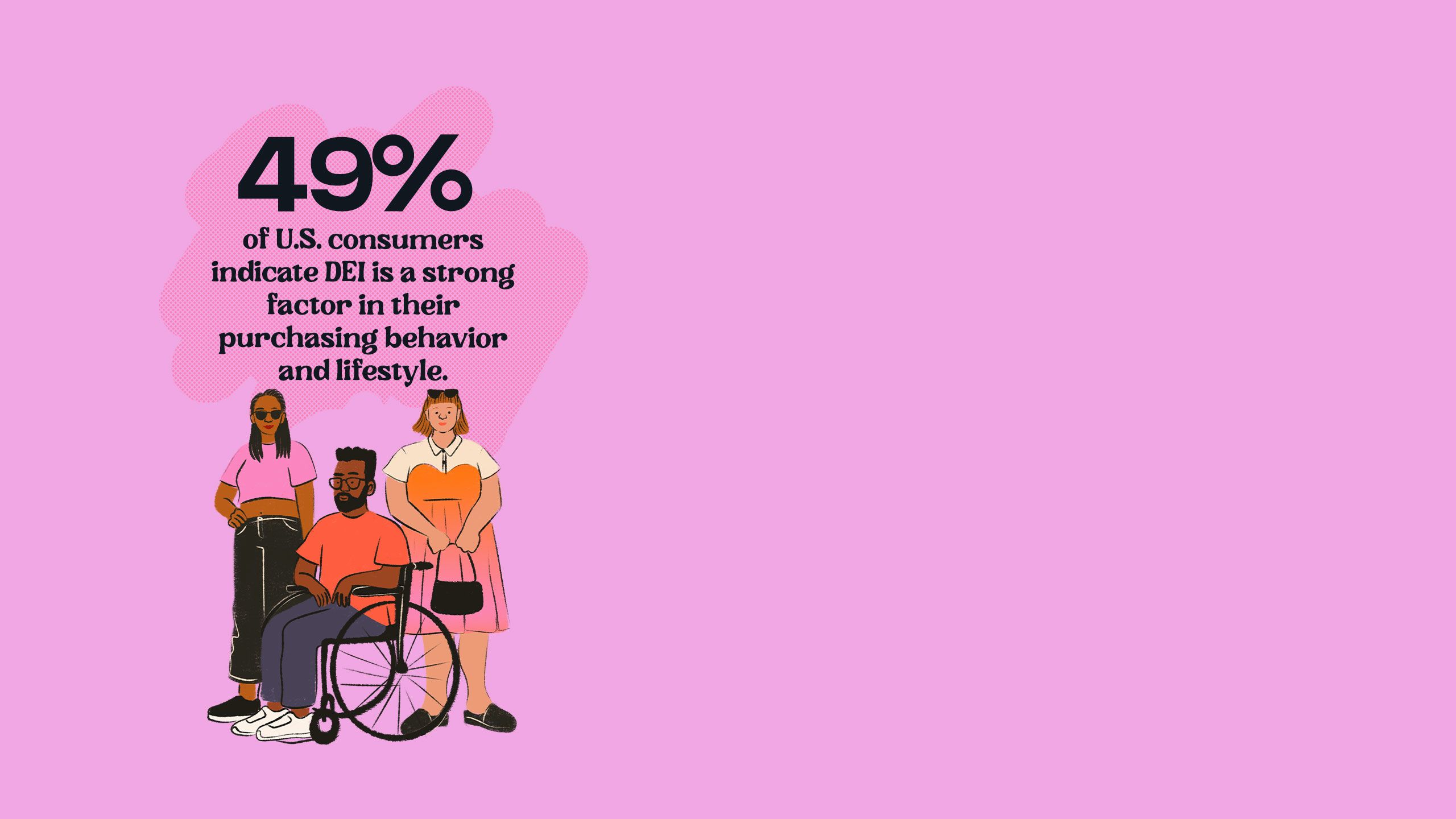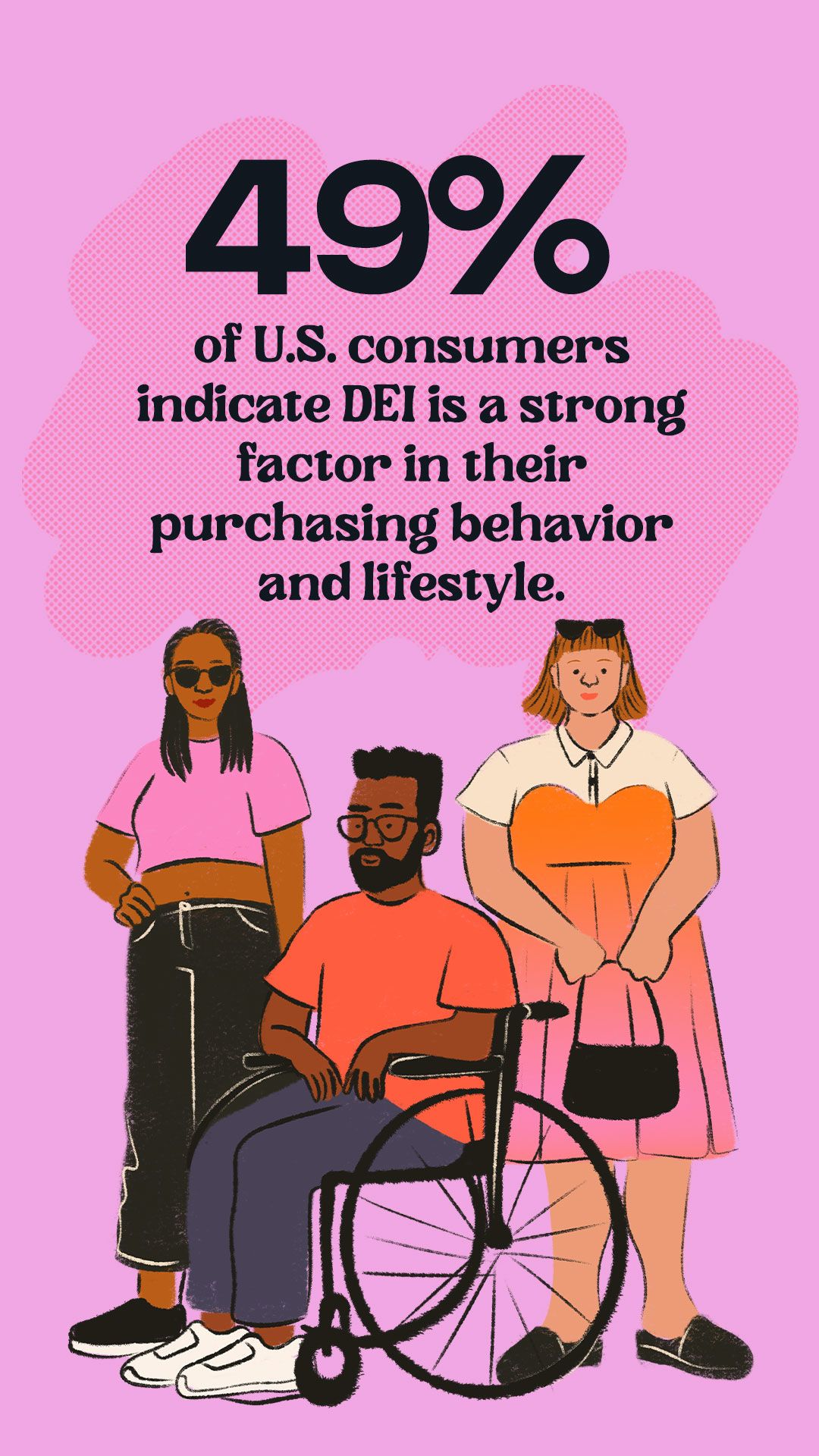
Brands really can make a difference.
Today, people expect a lot from the brands they buy from. Certainly, they want a good product or service at a fair price. And they want an experience that feels seamless and convenient.
But when it comes to building long-term, loyal relationships, they’re looking for brands that share their values. People want to feel good about the purchases they make. They want to be inspired by brands. They want to feel like the purchases they make contribute to the greater good.
In other words, people want to do business with brands that lead with their purpose.
The idea of being a brand with purpose isn’t new. Over the past decade-plus, companies have become increasingly aware that they can inspire change when they put their clearly defined purpose and values into action.
By forging a bond around shared values, brands are creating a unique competitive advantage that goes far beyond product specs and quarterly earnings. People want to spend money with companies that share their worldview. They support companies that make a difference.
Amazon Ads recently commissioned research from Environics Research to better understand the values that matter most to consumers. The survey of more than 1,000 U.S. consumers follows up on a similar 2021 study.
The results of the “Higher Impact 2022” research report show that people want brands to be advocates for the greater social good. In fact, 8 in 10 U.S. consumers surveyed said they have modified their way of life to concentrate more on the things that are really important to them. They want brands to reflect that.
What can your company do to authentically connect with consumers as a brand with purpose? Keep scrolling to find out more.


Brands really can make a difference.
Today, people expect a lot from the brands they buy from. Certainly, they want a good product or service at a fair price. And they want an experience that feels seamless and convenient.
But when it comes to building long-term, loyal relationships, they’re looking for brands that share their values. People want to feel good about the purchases they make. They want to be inspired by brands. They want to feel like the purchases they make contribute to the greater good.
In other words, people want to do business with brands that lead with their purpose.
The idea of being a brand with purpose isn’t new. Over the past decade-plus, companies have become increasingly aware that they can inspire change when they put their clearly defined purpose and values into action.
By forging a bond around shared values, brands are creating a unique competitive advantage that goes far beyond product specs and quarterly earnings. People want to spend money with companies that share their worldview. They support companies that make a difference.
Amazon Ads recently commissioned research from Environics Research to better understand the values that matter most to consumers. The survey of more than 1,000 U.S. consumers follows up on a similar 2021 study.
The results of the “Higher Impact 2022” research report show that people want brands to be advocates for the greater social good. In fact, 8 in 10 U.S. consumers surveyed said they have modified their way of life to concentrate more on the things that are really important to them. They want brands to reflect that.
What can your company do to authentically connect with consumers as a brand with purpose? Keep scrolling to find out more.

Values-based marketing puts your brand purpose at the core of everything you do. It becomes the framework for your branding and your values become infused in the elements of your company’s overall messaging. Your values drive your branding, not the other way around.
When done effectively, leading with brand values can free you to take a stance on social or environmental issues because your advocacy and actions align with your clearly defined values. These actions add another dimension to your organization; one that becomes a key part of your overall customer experience by creating a meaningful connection with your consumers.
Consumers are eager to know where brands stand on important social issues, especially in tumultuous times. They’re turning to brands to inspire their own actions. The “Higher Impact 2022” report found that 81% of U.S. consumers agree that it’s important for brands to take action during tough times such as a humanitarian crisis or in response to a natural disaster.
When your brand jumps at the chance to make a positive impact, based on its values and purpose, it frames itself as a responsible global citizen that consumers can look up to. That’s supported by the report, as the percent of U.S. consumers more likely to purchase an item from a brand willing to take a stance on social issues and conflicts jumped up 12 points this year to 67%.
Brand Purpose in Action
State Farm’s mission is to help people manage the risks of everyday life, recover from the unexpected and realize their dreams. So, tackling the issue of food insecurity through its support of Feeding America is a natural extension of those values. As the issue rose in importance as people struggled during the Covid pandemic, State Farm teamed with Amazon Ads to not only support the cause but to connect with consumers so they could take part, too.
The campaign included developing a custom landing page and using AmazonSmile to offer customers a way to give back to food banks in Houston, Detroit and Los Angeles by letting them add non-perishable items to their carts to send directly to the food bank of their choosing.
To reach a wider audience, the campaign used a homepage takeover on the Amazon homepage, combined with Fire Tablet display media, and video ads—including online video and streaming video. The initiative reached hundreds of millions of shoppers on Amazon across desktop and mobile. With a 97.8% streaming video completion rate, the brand was able to engage audiences and create more traffic to the custom landing page.

Values-based marketing puts your brand purpose at the core of everything you do. It becomes the framework for your branding and your values become infused in the elements of your company’s overall messaging. Your values drive your branding, not the other way around.
When done effectively, leading with brand values can free you to take a stance on social or environmental issues because your advocacy and actions align with your clearly defined values. These actions add another dimension to your organization; one that becomes a key part of your overall customer experience by creating a meaningful connection with your consumers.
Consumers are eager to know where brands stand on important social issues, especially in tumultuous times. They’re turning to brands to inspire their own actions. The “Higher Impact 2022” report found that 81% of U.S. consumers agree that it’s important for brands to take action during tough times such as a humanitarian crisis or in response to a natural disaster.

When your brand jumps at the chance to make a positive impact, based on its values and purpose, it frames itself as a responsible global citizen that consumers can look up to. That’s supported by the report, as the percent of U.S. consumers more likely to purchase an item from a brand willing to take a stance on social issues and conflicts jumped up 12 points this year to 67%.
Brand Purpose in Action
State Farm’s mission is to help people manage the risks of everyday life, recover from the unexpected and realize their dreams. So, tackling the issue of food insecurity through its support of Feeding America is a natural extension of those values. As the issue rose in importance as people struggled during the Covid pandemic, State Farm teamed with Amazon Ads to not only support the cause but to connect with consumers so they could take part, too.
The campaign included developing a custom landing page and using AmazonSmile to offer customers a way to give back to food banks in Houston, Detroit and Los Angeles by letting them add non-perishable items to their carts to send directly to the food bank of their choosing.
To reach a wider audience, the campaign used a homepage takeover on the Amazon homepage, combined with Fire Tablet display media, and video ads—including online video and streaming video. The initiative reached hundreds of millions of shoppers on Amazon across desktop and mobile. With a 97.8% streaming video completion rate, the brand was able to engage audiences and create more traffic to the custom landing page.

More and more consumers have taken an active interest in sustainability, embracing new practices in their daily lives and making purchases that have a lower impact on the environment. And they expect brands to do the same.
According to the “Higher Impact 2022” report, sustainability has become increasingly important for approximately 6 in 10 U.S. consumers over the past three years. This illustrates that sustainability isn’t just a trend, and it’s on the minds of many consumers.
And with U.S. consumer awareness of sustainability at 77% saying they were familiar with the topic, many consumers (74%) say they’re tired of brands acting like they are exempt from environmental responsibility. That’s up 3 points from 2021.
As you take action to make your brand more sustainable, be aware of some of the barriers that consumers have identified as roadblocks to buying the sustainable products they’re interested in. As you address those issues, include relevant messaging within your campaigns to increase awareness and aid them in their shopping research.
Brand Purpose in Action
From its own Healthy Lives Mission to partnerships with NGOs and industry peers, to research, products and brand messaging, sustainability is an essential element of the Johnson & Johnson Consumer Health business. Its brands like Listerine, Neutrogena, Johnson’s, Le Petit Marseillais OGX and Nicorette all have more-sustainable products and programs, and keeping their customers informed about those efforts is important.
For Earth Day 2022, Johnson & Johnson Consumer Health leveraged the Climate Pledge Friendly label on Amazon Ads for several brands, including Neutrogena, to help highlight its more-sustainable products to consumers. Products with that label have met one or more sustainability-related certifications that help preserve the natural world. Brands like those of Johnson & Johnson Consumer Health could showcase those Climate Pledge Friendly products on a separate page in their brand's store on Amazon. This can help customers evaluate and discover products that are more sustainable.

More and more consumers have taken an active interest in sustainability, embracing new practices in their daily lives and making purchases that have a lower impact on the environment. And they expect brands to do the same.
According to the “Higher Impact 2022” report, sustainability has become increasingly important for approximately 6 in 10 U.S. consumers over the past three years. This illustrates that sustainability isn’t just a trend, and it’s on the minds of many consumers.
And with U.S. consumer awareness of sustainability at 77% saying they were familiar with the topic, many consumers (74%) say they’re tired of brands acting like they are exempt from environmental responsibility. That’s up 3 points from 2021.
As you take action to make your brand more sustainable, be aware of some of the barriers that consumers have identified as roadblocks to buying the sustainable products they’re interested in. As you address those issues, include relevant messaging within your campaigns to increase awareness and aid them in their shopping research.

Brand Purpose in Action
From its own Healthy Lives Mission to partnerships with NGOs and industry peers, to research, products and brand messaging, sustainability is an essential element of the Johnson & Johnson Consumer Health business. Its brands like Listerine, Neutrogena, Johnson’s, Le Petit Marseillais OGX and Nicorette all have more-sustainable products and programs, and keeping their customers informed about those efforts is important.
For Earth Day 2022, Johnson & Johnson Consumer Health leveraged the Climate Pledge Friendly label on Amazon Ads for several brands, including Neutrogena, to help highlight its more-sustainable products to consumers. Products with that label have met one or more sustainability-related certifications that help preserve the natural world. Brands like those of Johnson & Johnson Consumer Health could showcase those Climate Pledge Friendly products on a separate page in their brand's store on Amazon. This can help customers evaluate and discover products that are more sustainable.

Diversity, equity and inclusion is on the minds of U.S. consumers. According to the “Higher Impact 2022” report, nearly three-quarters of U.S. consumers say it’s important to them that the brands they buy from promote DEI. Representation matters, and consumers want brands to take a stand on DEI issues.
U.S. consumers believe brands should celebrate diversity in their ad campaigns. By the numbers, 72% want to see more diversity in advertising—that means people of all ages, genders, races and sexual identities.
When discussing DEI, authenticity is critical. But what does that look like? U.S. consumers in the survey were almost evenly divided. More than half (52%) feel that the most authentic way to demonstrate commitment is by supporting broader actions and causes, while 48% feel it’s more authentic to demonstrate commitment directly through a brand’s products and services. This split in opinion suggests that brands may need a multi-pronged approach that includes a mix of broader commitments as well as relevant products and services to meet consumer expectations.
As for gauging which brands are truly committed to supporting DEI issues and initiatives, consumers look to DEI experts, advocates and groups that track companies’ activities on the issue. They also listen to family, friends and others they trust for information on which brands align with their DEI values.
Brand Purpose in Action
Following the summer of 2020, which saw social unrest and an increased call for social justice, the team at LIFEWTR, a premium water brand, decided it needed to take action.
Known for its bottles that showcase works of art from various artists, including those from underrepresented groups, LIFEWTR launched “Black Art Rising,” an immersive digital experience featuring the work of eight Black artists that was reminiscent of visiting an art gallery. Building off this campaign, the brand developed a limited edition “Black Art Rising” bottle series for Black History Month, featuring the work of three Black artists: Adler Guerrier, Dawn Okoro and Tajh Rust.
As part of this initiative, LIFEWTR transformed its store on Amazon into a virtual art gallery, showcasing the artists and their work, as well as including links to their websites for increased visibility. Also displayed on the Amazon store page was LIFEWTR’s commitment to donate to local organizations that support Black creatives, as selected by the artists.

Diversity, equity and inclusion is on the minds of U.S. consumers. According to the “Higher Impact 2022” report, nearly three-quarters of U.S. consumers say it’s important to them that the brands they buy from promote DEI. Representation matters, and consumers want brands to take a stand on DEI issues.
U.S. consumers believe brands should celebrate diversity in their ad campaigns. By the numbers, 72% want to see more diversity in advertising—that means people of all ages, genders, races and sexual identities.
When discussing DEI, authenticity is critical. But what does that look like? U.S. consumers in the survey were almost evenly divided. More than half (52%) feel that the most authentic way to demonstrate commitment is by supporting broader actions and causes, while 48% feel it’s more authentic to demonstrate commitment directly through a brand’s products and services. This split in opinion suggests that brands may need a multi-pronged approach that includes a mix of broader commitments as well as relevant products and services to meet consumer expectations.
As for gauging which brands are truly committed to supporting DEI issues and initiatives, consumers look to DEI experts, advocates and groups that track companies’ activities on the issue. They also listen to family, friends and others they trust for information on which brands align with their DEI values.

Brand Purpose in Action
Following the summer of 2020, which saw social unrest and an increased call for social justice, the team at LIFEWTR, a premium water brand, decided it needed to take action.
Known for its bottles that showcase works of art from various artists, including those from underrepresented groups, LIFEWTR launched “Black Art Rising,” an immersive digital experience featuring the work of eight Black artists that was reminiscent of visiting an art gallery. Building off this campaign, the brand developed a limited edition “Black Art Rising” bottle series for Black History Month, featuring the work of three Black artists: Adler Guerrier, Dawn Okoro and Tajh Rust.
As part of this initiative, LIFEWTR transformed its store on Amazon into a virtual art gallery, showcasing the artists and their work, as well as including links to their websites for increased visibility. Also displayed on the Amazon store page was LIFEWTR’s commitment to donate to local organizations that support Black creatives, as selected by the artists.

Amazon Ads helps brands design ad experiences that delight customers and deliver meaningful business results. With hundreds of millions of global active customer accounts, and first-party insights into shopping, streaming and browsing, brands can craft relevant campaigns that enhance the customer experience. Solutions on Amazon.com, services like Twitch, Freevee, Alexa, Amazon Music’s ad-supported tier, and partnerships with third-party publishers and exchanges make Amazon Ads an amplifier for brands to reach the right audiences in the right places, both on and off Amazon. Read more insights from the Higher Impact 2022 report.
Illustration by Haley Tippmann


Amazon Ads helps brands design ad experiences that delight customers and deliver meaningful business results. With hundreds of millions of global active customer accounts, and first-party insights into shopping, streaming and browsing, brands can craft relevant campaigns that enhance the customer experience. Solutions on Amazon.com, services like Twitch, Freevee, Alexa, Amazon Music’s ad-supported tier, and partnerships with third-party publishers and exchanges make Amazon Ads an amplifier for brands to reach the right audiences in the right places, both on and off Amazon. Read more insights from the Higher Impact 2022 report.
Illustration by Haley Tippmann


 Built with Shorthand
Built with Shorthand





